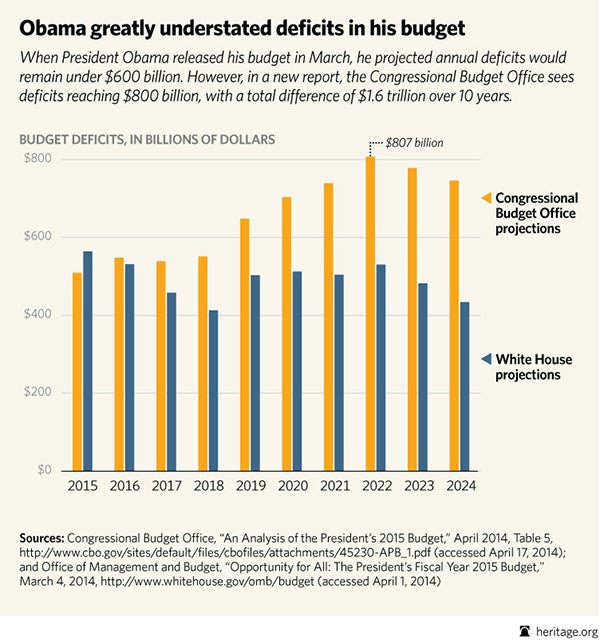CBO Report Shows President’s Budget Relies on Rosy Economic Assumptions
Rachel Greszler /
According to the non-partisan Congressional Budget Office (CBO), total deficits under President Obama’s 2015 budget proposal would be $1.7 trillion higher than the administration’s previous estimates. This is no small difference; it is equivalent to one and a half sequesters.
So, how is it that CBO and the administration can project such vastly different budget outcomes when examining the exact same set of policies? Most of the difference ($1.3 trillion) comes from the administration’s use of overly optimistic economic projections. By simply assuming an improbably high level of economic growth—along with income and profits, the administration is able to paint a much rosier picture of its budget.
For example, over the 2015–2024 period, the administration assumes the following (all compared to the CBO’s projections):
- GDP will be 3 percent higher;
- Incomes will be between 1 and 2 percent higher;
- Profits will be 10 percent higher;
- Tax revenues will be 4 percent higher; and
- Interest rates will be between 7 and 9 percent lower
This is not the first time the administration has employed overly optimistic economic projections to garner support for its policies. According to an analysis by the administration’s economists back in 2009, enacting the president’s proposed stimulus package would have prevented the unemployment rate from ever rising above 7.9 percent. Despite passage of the stimulus, the unemployment rate rose to 10 percent, and even today, nearly five years after the recession officially ended, the unemployment rate remains elevated.
To be sure, we certainly want the president of the United States to be optimistic about the long-run prospects of U.S. economic growth—just not when it comes to static budget projections that are heavily shaped by the underlying economic assumptions . Optimistic budget assumptions can lead to bad policies that produce unsustainable spending and deficits, while harming economic growth. Indeed, overly optimistic budget assumptions can be found at the heart of such catastrophes as the real estate bubble, the multi-trillion dollar funding gap in state and local pensions, and recent municipal bankruptcies.
On paper, hopeful economic assumptions may be able to hide the harmful effects of the president’s big-government policies. In reality, however, there will be no hiding from misplaced policies such as: more than one trillion in new taxes and new spending; compromised American security; destructive meddling in K-12 and higher education; and increased government dependency.
Budget projections should be based on realistic, if not conservative, economic assumptions. The administration’s use of overly optimistic economic assumptions is not only misleading—it could prove outright destructive. Once enacted, policies become engrained and a retroactive reflection of actual versus projected costs will be of little use.
For more details on the policies in the president’s budget, view President Obama’s 2015 Budget: How Government Expansion Will Limit Opportunity, Slow Economic Growth, and Erode Financial and National Security.

